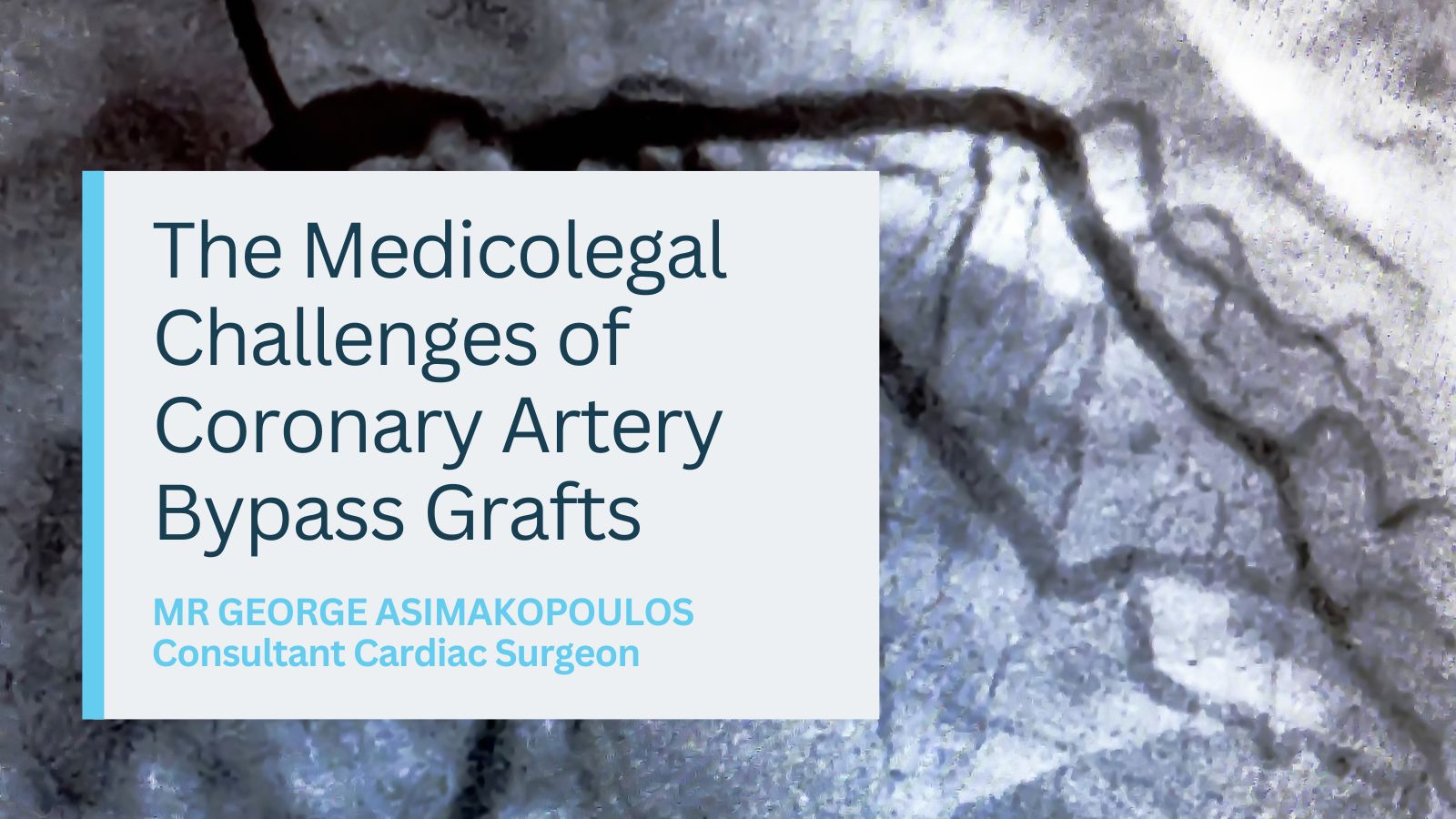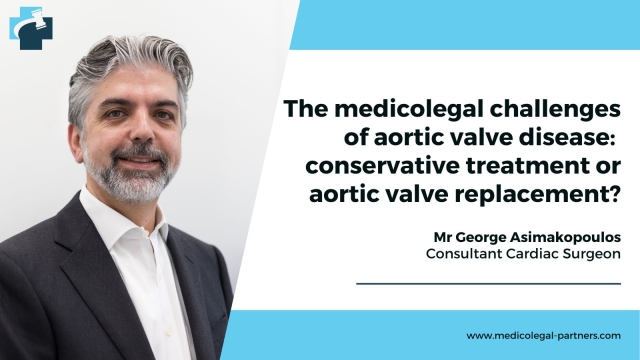The Medicolegal Challenges of Coronary Artery Bypass Grafts

Although percutaneous coronary intervention (PCI) is viewed as a less invasive treatment, coronary artery bypass grafting (CABG) is now accepted as a highly effective solution to obstructive disease of the coronary arteries in certain patients. CABG, which is also known as heart bypass surgery, involves taking a blood vessel from another part of the body, usually the chest, leg or arm, and attaching it above and below the damaged area of the coronary artery.
Guidelines published by the European Society of Cardiology (ESC) and the European Association for Cardiothoracic Surgery (EACTS) assist the Heart Team in the decision making concerning the management of Coronary Artery Disease (CAD)1 . Several randomised trials have provided data that define the group of patients that are likely to benefit from CABG. The most widely referenced study investigating outcomes after CABG versus PCI is SYNTAX2. Improvements in CABG mean that long-term patency of the grafts can be expected, which compares favourably with the higher requirement for reintervention after percutaneous treatments in appropriately selected patients. The benefits of the operation are prognostic and also symptomatic: cardiac function is improved in patients with pre-operative cardiac dysfunction and ischaemic but viable myocardium.
However, the use of grafts is not without its challenges and there are some important considerations which must be taken into account before the procedure is undertaken. When it comes to the choice of graft material, several options are available. The Internal Mammary Artery (IMA) is the graft of choice for the revascularisation of the left anterior descending coronary artery (LAD). The superiority of the left IMA as a graft has been known for over 40 years3. As the quality and application of the bypass graft are major predictors of both survival and the development of significant complications, appropriate selection is vital. Patients should, nearly aways, receive a LIMA graft to the LAD. A second arterial graft, such as the right IMA or the radial artery, is desirable when the coronary anatomy and patient age and fitness allow it1.
Issues that may lead to graft failure include poor graft preparation, inappropriate or poor operative technique and patient factors. Most graft failures arise due to events that occur early in the procedure. Graft ischemia can be prevented through careful harvesting, vasodilatation and storage prior to implantation. Vasodilatation of arterial grafts is indicated to minimise the risk of potentially lethal graft spasm, but care should be taken to protect the endothelial function of the graft. The long-term patency of vein grafts can be improved by a daily dose of aspirin, assuming there are no contraindications, which should commence within 24 hours of the procedure. However, there is no evidence that aspirin improves the patency of arterial grafts.
Historically, saphenous vein grafts (SVG) were considered better than internal mammary artery (IMA) grafts, and were used more commonly. This is because the SVG has a low physiological resistance to coronary blood flow, which leads to higher coronary flow as measured during surgery. However, it has since been demonstrated that IMA grafts can adapt to higher flow demands by increasing in diameter. These changes, which are usually apparent a few weeks after surgery, can result in coronary flow up to 2.4 times higher than in the resting state.
Another potential issue with SVGs is that physical damage of the endothelial layer of the vessel often occurs during preparation of the graft if high-pressure dilatation of the vein takes place. This loss of function can result in degenerative and atherosclerotic processes being initiated when the graft is implanted into the arterial circulatory system. Local narrowing with intimal hyperplasia and degenerative dilation often occurs and can ultimately lead to atherosclerosis (narrowed arteries).
Conversely, IMA grafts differ in their tissue structure from both the coronary artery and the saphenous vein. A thin smooth muscle layer, abundant elastic fibres and tight lamina interna mean that ITA grafts are inherently resistant to atherosclerosis. Furthermore, the superior secretion of nitrous oxide (NO) by IMA grafts means that beneficial metabolic effects are not only maintained in the graft itself, but also in the recipient coronary artery. The secretion of NO helps to prevent platelet aggregation, thrombosis, intimal hyperplasia and inflammatory cell migration, all of which can lead to coronary obstruction. Not surprisingly, IMA grafts are currently considered the preferred option, for the revascularisation of the left coronary artery system in particular, in most patients.
A number of patient factors influence the success of coronary artery bypass grafts. Patients with diabetes mellitus pose particular problems. Disease of the coronary arteries tends to be more diffuse in these patients than in those without diabetes, and often affects multiple blood vessels. Furthermore, the saphenous vein is often more calcified and changes are seen in all layers of the vessel wall. Therefore, IMA grafts should be strongly considered. However, there is an increased risk of sternal infection following IMA harvesting, which is more than doubled in diabetic patients. Sternal wound infections increase significantly when both IMAs are used. The significant prognostic benefits of placing a IMA graft to the LAD, however, usually outweigh the risks of a wound infection.
Other complications include increased rates of stroke, myocardial infarction, recurrent angina and mortality, as well as an increased need for reintervention.
Patients with renal disease suffer from an increased risk of early complications, such as further loss of kidney function, infections and progressive loss of graft function. Thus, the use of bilateral ITA grafts may not be justified.
Improvements in patient selection, operative techniques and critical care management mean that CABG is now safe for most suitable patients with coronary artery disease, even when extensive grafting is required. Peri-operative mortality after elective CABG in Great Britain and Ireland is now under 1%4 . With careful selection of graft material and good preparation, long-term graft patency can be achieved. Secondary prevention of coronary disease, encompassing smoking cessation, the use of cholesterol-lowering drugs and the control of hypertension and diabetes, should ensure even better patient outcomes.
References:
- The Task Force on myocardial revascularization of the European Society of Cardiology (ESC) and European Association for Cardio-Thoracic Surgery (EACTS). 2018 ESC/EACTS Guidelines on myocardial revascularization. Eur Heart J. 2019;40:87–165.
- Serruys PW, Morice MC, Kappetein AP, Colombo A, Holmes DR, Mack MJ, Stahle E, Feldman TE, van den Brand M, Bass EJ, Van Dyck N, Leadley K, Dawkins KD, Mohr FW; SYNTAX Investigators S. Percutaneous coronary intervention versus coronary-artery bypass grafting for severe coronary artery disease. N Engl J Med 2009;360:961–972.
- Boylan MJ, Lytle BW, Loop FD, Taylor PC, Borsh JA, Goormastic M, Cosgrove DM. Surgical treatment of isolated left anterior descending coronary stenosis. Comparison of left internal mammary artery and venous autograft at 18 to 20 years of follow-up. J Thorac Cardiovasc Surg 1994;107:657–662.
- The Society for Cardiothoracic Surgery in Great Britain and Ireland. National Cardiac Surgery Activity and Outcomes Report 2002–2016 (Blue Book).
Further reading:
Buxton BF, Hayward PA, Newcomb AE, Moten S, Seevanayagam S, Gordon I. Choice of conduits for coronary artery bypass grafting: craft or science? Eur J Cardiothorac Surg. 2009 Apr;35(4):658-70.
Kitamura S. Physiological and metabolic effects of grafts in coronary artery bypass surgery. Circ J. 2011;75(4):766-72.


